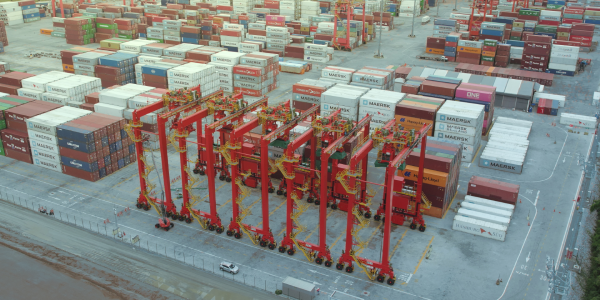
Porto Itapoá will be the only port in SC with Maersk’s ASAS service
Programa Ampliar has already given life to more than 60 projects developed by the community
Six types of whales and dolphins that can be seen in Baía da Babitonga and its region
Porto Itapoá maintains a Cetacean Monitoring Program to accompany these beautiful animals, which often visit the region
Cetaceans are mammals fully adapted to the aquatic environment: whales and dolphins belong in this group. In total, there are more than 80 species, which live all over the world. Some species can be found in rivers, but most of them live in the sea
Through the Cetacean Monitoring Program, maintained by Porto Itapoá, researcher Gilberto Ougo (Acquaplan – Tecnologia e Consultoria Ambiental) monitors and evaluates the quality of life of the species that frequent the region of Itapoá and Baía da Babitonga (Babitonga Bay). “Cetaceans are fascinating!
They have a unique ability to understand the environment. They have strong social relationships, protection and a sense of freedom”, explains the researcher.
The waters of the bay and its surroundings serve as a home for many of these friendly animals. They also serve as a nursery for some species that breed in the region and migrate seasonally. “These are animals that show us how healthy of the environment we live in truly is. Conserving these populations means protecting rivers and oceans and guaranteeing our quality of life. For these and many other reasons, they deserve a lot of attention”, says Ougo. Check out some species that can be seen in the region:
Porpoise – Pontoporia blainvillei
Porpoises are one of the smallest types of dolphin, with a body reaching up to 1.60m. They live from the coast of Espírito Santo to the Gulf of San Matias, in Argentina, and feed on fish, squid and crustaceans. They behave discreetly and do not jump like other dolphin species. In Babitonga Bay, they usually live in groups of 2 to 5 individuals and can be seen throughout the year.
Guiana dolphin – Sotalia guianensis
The Guiana dolphin is very sociable and usually lives in groups and they live from Central America to the coast of Santa Catarina. They can reach 2.20 m and have a gray color pattern on the back, with two lighter side stripes. This coastal species can be seen in Babitonga Bay throughout the year. They feed on fish, squid and crustaceans. They have a feeding location very close to the pier of Porto Itapoá and can always be seen there.
Bottlenose dolphin – Tursiops sp.
This funny-named dolphin can be found all over the planet, both in coastal and oceanic areas. Due to this behavior, they perform daily migrations of many kilometers. They are most easily found in tropical, subtropical and temperate waters.
With a length of up to 3.80 m, it features a robust body and a dark gray color pattern. They are sporadically seen in Babitonga Bay, usually at the mouth of the bay and adjacent coastal regions.
Southern right whale – Eubalaena australis
The first whale on our list, the right whale is a large animal, reaching up to 18m in length. This species is characterized by the absence of a dorsal fin and by having several calluses on the head due to the thickening of the skin. These calluses are used by researchers to identify individuals (a bit like our fingerprints). Another striking feature is the “V”-shaped breath spray.
It is a migratory species that inhabits the Southern hemisphere that feeds in Antarctica and reproduces and breeds in warmer waters, mainly in the Center-South Coast of Santa Catarina (the Environmental Protection Area of this species of Whale). The reproductive period in Brazil runs from July to November, the most common time for sightings of these beautiful animals.
Humpback whale – Megaptera novaeangliae
Humpback whales have large pectoral fins, which measure approximately one third of their length, which can reach 16m. The caudal fin is serrated and white on the inside of the tail with asymmetrical spots. These spots are used by researchers to identify individuals.
They are also a migratory species and can be found in all the world’s oceans, feeding in Antarctica and breeding and procreating in warmer waters. The main breeding region in Brazil is Banco dos Abrolhos (Abrolhos Bank), located in the extreme south of Bahia and northern Espírito Santo. The reproductive period runs from July to November, when they can be seen in the waters of Babitonga, usually in the mouth of the bay and nearby regions.
In 2021, there was a large concentration of juvenile animals of this species in Santa Catarina, many of them at the mouth of Babitonga Bay and on the nearby beaches.
Bryde’s whale – Balaenoptera brydei
The Bryde’s whale is one of the least known whales and, unlike other migratory species, it does not occur at the poles and may show a pattern of residence in some area. They reach up to 15m in length and feed mainly on sardines and anchovies.
Body coloration varies from dark gray to black on the back and gray or white on the belly. The dorsal fin is high and well falcated and often irregular. They have three longitudinal ridges on the dorsal region of the head.
Their occurrence is rare in Babitonga Bay. A single individual remained in Babitonga Bay for a few months in the year 2020. It may appear more frequently in coastal regions adjacent to the bay.





